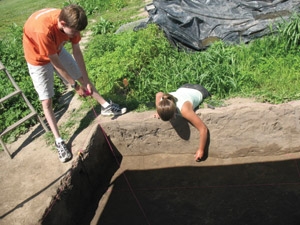Cahokia mounds reveal a vast copper workshop

- Junior Sarah Luongo and Steven Broderick, Class of 2009, work on excavations overlying a copper workshop found in Cahokia Mounds. A team of researchers led by John Kelly, Washington University archaeology professor, and James Brown from Northwestern University discovered a copper workshop that will provide insight into the lives of the Cahokians who leaved near the mounds more than 1,000 years ago. (Courtesy of John Kelly)
Native Americans began to settle the area around East St. Louis in 1000 A.D., and the city had a population boom 50 years later. More than 20,000 people lived in the city during Cahokia’s Golden Age.
Four plazas were built around Monk’s Mound, believed to be the largest mound of Cahokia. The mound is approximately as large as the Danforth Campus.
Today, the Cahokia Mounds State Historic Site still has 80 mounds of various sizes out of the more than 100 mounds built. These were created when Cahokians dismantled constructed buildings and buried the pieces underneath the earth. These buildings were sometimes reconstructed.
“One of the important elements in Indian cosmology is rebirth,” Kelly said. “They look out at the world around them; everything is dead now, but in two months it’s going to come back again and be reborn…We start with the building, the burial of the building, the rebirth of the building and the burial again.”
Only 1 percent of these mounds have been excavated to date. The copper workshop was found within Mound 34, where, according to Kelly, pieces of copper were discovered. Cahokians used the metal to create religious ornaments and other decorative items. It’s hypothesized that workers hammered and heated the copper to 600 degrees Celsius to flatten out the metal. The sheets were pressed onto carved wooden templates to create the ornament. The metal may have been obtained from the Great Lakes region. Copper specifically was used because it was considered to have special properties.
After four centuries, the population of Cahokia began to decline and the city was abandoned. Although it remains unknown why the Cahokians left their city, theories range from environmental factors, like drought driving away inhabitants, to geopolitical issues. Artifacts from 1200 A.D. uncovered in excavations indicate a shift in focus from community life to warfare. The copper workshop itself is dated to 1200 A.D. The Osage tribe located in southern Missouri may have originated from Cahokia. Researchers currently work with the Osage tribe as they excavate, preventing changes to the mound.
Kelly and Brown won a grant from the National Geographic Society to continue their work two years ago. The team turns to current Native American culture to develop their hypotheses and theories regarding the lifestyles of the Cahokians.
Cahokia also presents a unique opportunity to examine the early formation of a city.
“What we’re looking at here is the very beginning of…urbanism,” Kelly said. “So it hasn’t had a chance to really flourish; it’s just starting to come into existence.”
The excavation team hopes to continue its work in the summer. Amateur archaeologist Gregory Perino had first found the copper workshop. In the 1950s, he had been hired to find artifacts for museum display. Kelly and Brown used his maps to retrace the copper workshop. The team now hopes to collect soil samples from the mound to test for copper levels.

No comments:
Post a Comment